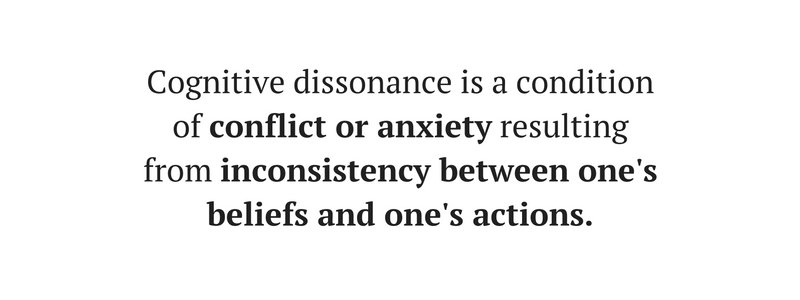
You've been a smoker for years. You started because your friends smoked; you couldn't resist the peer pressure. Now you're smoking at least one pack a day, sometimes two.
Recently your health has taken a turn for the worse. That cough is getting rougher and you're out of breath climbing stairs. You visit your doctor who recommends you stop smoking.
You sign up for a program but after two weeks stop. Instead of admitting that you have an addiction and that quitting is hard, you tell yourself you enjoy smoking, and that it could be worse - your friends smoke far more.
Congratulations! You've just fallen victim to cognitive dissonance.

Were the tasks interesting and enjoyable?
In 1959 Leon Festinger performed an experiment where participants were informed that the experiment focused on "Measures of Performance". They were split into two groups: the first group was provided no introduction about the tasks they would be performing, whereas the second group was given an introduction by an experimenter who presented the tasks with a positive tone.
The tasks were, however, designed to be monotonous. Participants were asked to put spools on a tray with one handing, take them off, and put them back on again - for one-and-a-half hours. When they were finished, they spent the next thirty minutes turning 48 square pegs.
After the tests each participant was interviewed regarding how enjoyable the tasks were. From this point on, the experiment changes. Some participants were sent home: this was the control group. The remaining subjects were asked to take the place of the experimenter in giving the positive introduction to the next group of participants. Half of them were paid $20 to do this, while the other half per paid just $1.
The participants were again interviewed, with one of the questions asking whether they found the experiment enjoyable. You can see a video of the experiment in action below:
Both the control group and the group where participants were paid $20 rated the task negatively, indicating that they didn't find it enjoyable. The group that was paid $1, however, rated the task positively, indicating that they found it enjoyable.
Both the control group and the group paid $20 rated the task negatively - they didn't find it enjoyable; however, the group that was paid only $1 couldn't find any justification for doing the task. Instead of accepting that they were paid poorly to perform a boring task, they conclude that the task must have been enjoyable.
The fox and the grapes
Aesop is a storyteller believed to have live in ancient Greece between 620 and 564 BCE. He is credited with a number of fables, one of which is called "The fox and the grapes":
Driven by hunger, a fox tried to reach some grapes hanging high on the vine but was unable to, although he leaped with all his strength. As he went away, the fox remarked 'Oh, you aren't even ripe yet! I don't need any sour grapes.'
This is a classic example of cognitive dissonance. Instead of admitting his failure in obtaining the grapes, the fox rationalises that they are not worth having.
Cognitive dissonance on steemit
You've written a post on steemit. You've poured your heart and soul into the post and are ready to reap the rewards - you can feel the up-votes coming.
Twelve hours later your article has sadly only attracted a few up-votes and earned you a mere $0.04.

To resolve the dissonance between believing that your post is of high quality and deserves to trend against the reality that it received few up-votes, you tell yourself the timing was off, the system is rigged, and that whales aren't up-voting fairly.
What can we do?
Cognitive dissonance happens a lot. Any time you have conflicting thoughts that need resolving, cognitive dissonance is around the corner waiting to pounce.
Try to recognise when you feel uncomfortable making a decision. Stop and see if you can find the inner conflict.
Banner photo by Niel Conway used under the CC-BY-2.0 license. Changes were made to the original.
Other posts in the series:
